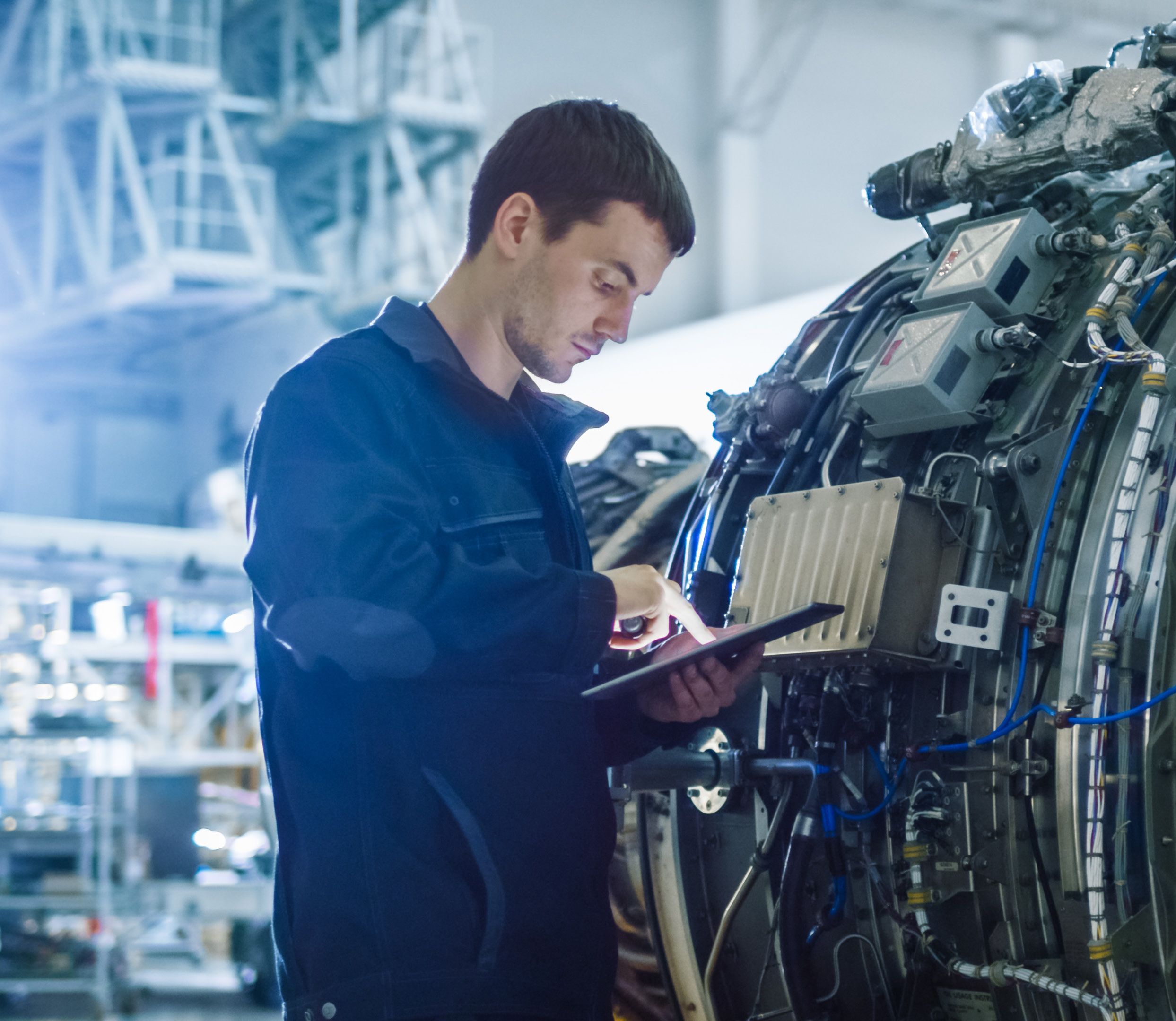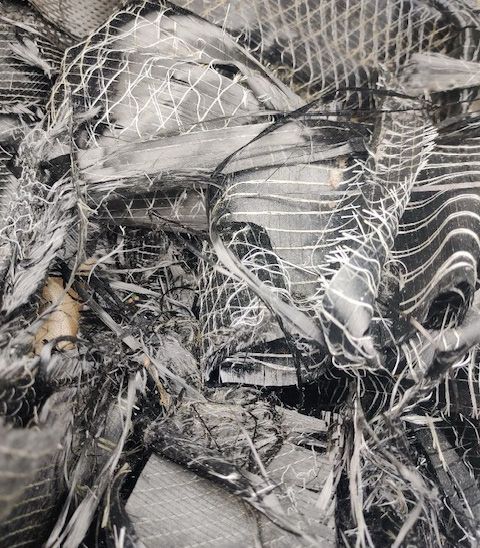Aviation is under ever-increasing scrutiny on its ESG impact. Despite often-seen images of plane ‘boneyards’ in the desert, the end of an aircraft’s service life does not equate to the end of its usefulness.
Today, a portion of the industry already focuses on functional parts being recovered from retired or decommissioned aircraft and other parts being repurposed or recycled responsibly. The technology being deployed to make the process more efficient and scalable, however, will only become more relevant in the years ahead, as circular economy principles are embedded throughout the value chain, from design to decommissioning. In this paper we put the spotlight on this often forgotten yet high-growth area.
How can retired aircraft hold significant value?
Even after over 20 years of service, retired aircraft can hold significant value. Intensified regulations and standards have led to innovations and practices that unlock value at various stages of the recycling and disposal process.
Tangible innovations stemming from this heightened scrutiny are unlocking value across the entire recycling and disposal process. Consequently, there has been a rise of specialized companies skilled in recycling and reusing aircraft components. These firms selectively deconstruct retired planes, extracting value from the vast majority of parts, aligning with sustainability goals, and reshaping the aviation industry’s approach to retired aircraft. They perform the initial inspection and assessment of the parts and components removed from an aircraft to determine their condition and suitability for reuse. Once deemed serviceable and after undergoing recommission processes and the required testing and certification, these parts are sold as used serviceable material (USM).
It is estimated that there will be around 1,100 retirements per year by 2038.1 A primary contributor is the age-related restriction in various countries, which is typically 15-25 years.2 The global commercial aircraft disassembling, dismantling, and recycling market is projected to grow to over USD14 billion by 2032, a CAGR of almost 8%.3
Advances in disassembly processes have enabled recycling of nearly 80% of aircraft components4 and over 90% of an aircraft’s weight can be reused or recycled.5,6 ~40-50% of an aircraft is returned to the parts distribution pipeline and used again in aircraft maintenance, with most of the remaining materials recycled and returned to the supply chain as raw materials.7
The most challenging aspects to process include alloys such as nickel and cobalt, and carbon fibre composites, which have become common in newer aircraft. Furthermore, some materials which have embedded flame retardants can contaminate recycling streams and raise health and safety concerns and so are currently excluded from recycling.

Suitability for reuse
During the dismantling of these aircraft, components undergo a comprehensive assessment to determine their suitability for reuse. For example:
- Powerplants (engines) are highly sought after in disassembly. In fact, they are typically more valuable than the rest of the aircraft combined.8 There is rising demand for engines, driven by global supply chain shortages, and even on a retired plane, the engines will tend to be younger / have seen less flight hours than the airframe due to spare switch-outs and high refurbishment rates.
- Landing gears are also among the most valuable components; a recovered landing gear can be worth up to five hundred thousand dollars.
- Auxiliary power units, electrical power, flight controls, avionics and navigation systems are also among the most highly valued components in a disassembly
- Interior fixtures such as cabin seating can be retrieved for reupholstering
These components, once they have undergone exhaustive inspections, tests, and certifications to ensure they meet or exceed all necessary airworthiness and safety standards, achieve the designation of USM. And it is not just components that are sought after. Aircraft are stripped for valuable metals like titanium, tungsten and copper. Even fluids, lubricants and the gasses contained in fire extinguishers can be recovered and recycled.
Demand drivers - The USM market growth is driven by:
Part of the rise in demand for USM is driven by the cost advantage it offers compared to the procurement of original equipment, making it a logical choice for airlines, lessors, and parts companies trying to save money. Certified USM parts are typically 20-40% cheaper than new parts.9 Consequently companies across the spectrum of the aviation industry, including airlines, maintenance organizations, and aircraft operators, often resort to USM to meet their fleet maintenance and repair needs.
The pricing dynamics within the industry have also become more competitive. As the demand for used aircraft parts grows, companies operating in the disassembly and part-out sector are striving to offer competitive pricing to attract customers.
Airlines globally are increasingly accepting USM material as they seek to reduce operating costs for their older aircraft. For example, Delta Air Lines have over ninety 737-800s with an average age exceeding 18 years, while Air France10 has over eighty A320s with an average age exceeding 24 years.
Aging fleets are a product of the escalating costs associated with new aircraft acquisition. To illustrate, as of 2023, the cost of a new single-aisle aircraft, such as the Boeing 737 or the Airbus A320, both workhorses of numerous commercial fleets, easily exceed USD100 million list prices.
Simultaneously, current challenges in the aerospace supply chain mean that the wait time for new engines, parts and aircraft is at all-time record levels. Additionally, the rapid rebound in air travel demand-surpassed expert predictions, and created a substantial need for surplus parts from part-out companies. USM can alleviate these pressures by facilitating the reuse and recycling of available parts now, bridging the gap between operator need and manufacturer capability.
The aviation sector is responsible for 2% of global human activity CO2 emissions.11 The total contribution from the sector could even be as high as 4-5% when non-CO2 effects are included. Consequently, it is facing pressure to prioritize sustainability. This has manifest with a clear, albeit very challenging sector goal of achieving net-zero carbon emissions12 by 2050.
The aviation industry has made significant progress in reducing emissions intensity, with a 55% reduction since 1990.13 However, the ability to meet the 2050 targets requires multiple simultaneous transformations across the value chain going well beyond improving fuel burn efficiencies. While increasing recycling in teardown might seem immaterial to the overall aircraft footprint, it gains importance as a percentage change for teardown-focused stakeholders. As lessors increase their transparency and broaden their ESG focus, circularity becomes vital, given increased institutional investor scrutiny. This shift underscores the importance of sustainable practices in aviation, including teardown and recycling, to meet the industry’s sustainability goals.
Given that the global commercial aircraft fleet size exceeded 28,800 in 2022, and is anticipated to grow to over 40,000 by mid-century, the reuse and recycling embodied in the concept of USM can lead to notable reductions in manufacturing waste and demand for new components. In essence, USM presents a dual advantage — it’s economically efficient and markedly bolsters the aviation sector’s eco-friendly initiatives.
In the context of aviation’s ongoing drive to reduce its environmental impact, there is general acknowledgement that end-of-life aircraft recycling is a priority. Effective recycling techniques today can recycle well over 90% of an aircraft’s weight, and nearly 100% of its engine parts. The industry body AFRA (Aircraft Fleet Recycling Association) was formed back in 2006 with a vision for making aviation more sustainable through recycling. It has developed Best Management Practices (BMPs) which significantly improve the management of end-of-life aircraft. And it’s not just disassemblers and material recyclers that are members of the association, players involved in the leasing of aircraft are now also joining - Avolon14 and ABL Aviation among recent members.
Technology enablers and ESG reporting accelerators
The industry is also becoming more inventive in terms of technologies employed for disassembly. Technologies like augmented reality (AR) and virtual reality (VR) are beginning to find applications in this industry, from cabin design15 to aircraft maintenance.16 These tools can potentially facilitate enhanced disassembly training for workers, provide more detailed visualizations of aircraft components, and even simulate the disassembly process.
Robotic systems are also now used in some facilities to carry out dismantling tasks. This approach increases speed and accuracy while reducing labor costs, offering an appealing method to streamline operations. For example, a European Horizon 2020 project is innovating a use case. Aircraft primarily use rivets for joining parts, hindering efficient recycling. The SUSTAINair project introduces Industry 4.0 tech to improve aircraft end-of-life processing. A robot head will be developed to detect and remove rivets, promoting alloy separation. This allows for the recovery of higher value recycled aircraft material.(17)
Finally, a notable development is the increasingly sophisticated use of data and data analytics to more accurately predict which components will yield the most value and capture operating and recovery KPIs for posterity. For example:
- AerFin, a UK based after-market solutions service provider, have developed an internal software programme that processes data to optimize the total value yield of serviceable components.18
- GA Telesis is an MRO that has built an algorithmic model driven forecasting tool that estimates the number of aircraft retiring through 2032 and is stated to be 98% accurate. The models also predict the demand for used serviceable materials, taking into account the variability in consumption of various components and materials for different aircraft platforms.19
- Michelin has been on a path towards embedding an RFID (radio frequency identification) tag in all its tires during the manufacturing process. Although not an example directly from aviation, this approach reduces waste, enhances resource efficiency, and offers valuable lessons for circularity in the sector. These tags store essential data about the tire’s manufacturing date, composition, and other relevant details, which has huge benefits for circularity and end-of-life. By scanning the RFID tags, recycling facilities can identify the tire’s materials and properties, making it easier to determine a tire’s second life prospects or its most appropriate recycling process. RFID is a technology already adapted for a variety of use cases in aviation and is likely to play an enhanced role in improving teardown efficiency.
Case Study: Plaswire
Context:
Both in the manufacture of new aircraft and their interior fit-out, and later at overhaul or teardown, there is significant waste in composites, carbon fibre and PVC alloys. Plaswire, a UK SME located within the Northern Irish aerospace cluster, is introducing new recycling capabilities to the aviation value chain in Europe and the US.
Challenge:
Complex polymers from aerospace and other sectors (e.g. wind turbine blades) are notoriously energy intensive to repurpose - not surprising given they’ve been designed for robustness.
Solution:
Plaswire has developed cost-effective, physical processes to re-purpose these complex polymers. By diverting waste polymers from landfill or incineration, the environmental footprint is reduced - 6 tonnes of CO2 avoided for each tonne of the polymer output produced - in a process with ISO9001, 14001, 45001, SC21 certification.
The output directly substitutes for virgin plastic, pre-cast concrete, wood and metal products for the construction and infrastructure sectors.
With a growing track record of recycling decommissioned wind turbine blades (which are designed to withstand decades of weather extremes), Plaswire is applying the same techniques now for clients with off-cuts at aircraft manufacture and fit-out stage, as well as with MRO at tear-down stage.



Other developments in the circular economy
Circular economy in aircraft operations and end-oflife management:
Through selective dismantling, Airbus initiated the PAMELA project (Process for Advanced Management of End-of-Life Aircraft), encompassing decommissioning, disassembly, and smart selective dismantling. The project demonstrated that 85% of an Airbus A300 aircraft’s weight can be recycled, reused, or recovered as secondary raw materials.
Establishment of standards for end-of-life aircraft management and recycling:
Boeing, recognizing the importance of aircraft recycling, was a contributing founder of the Aircraft Fleet Recycling Association (AFRA), establishing new standards for end-of-life aircraft management where retired aircraft are typically parked.
What is the relevance for Industry stakeholders?
The circular economy is a concept whose time has come. Aside from the compelling business case, it is clear that current materials usage will have to change to reduce anthropogenic impact on land and at sea. Circular supply chains offer all sectors a necessary opportunity to achieve this, all whilst reducing scope 3 emissions, shrinking consumption footprints, and transitioning to more sustainable business models. This transition will take time and will require deep strategic engagement throughout the sector. To conclude, we highlight some key takeaways by player type.
Original Equipment Manufacturers (OEM)
Aircraft OEMs like Boeing and Airbus are adopting circular design principles by working towards creating a closed materials loop where retired aircraft contribute to the creation of new ones. This involves designing aircraft with the goal of being easier to disassemble and recycle at the end of their operational life, rethinking material choices to prioritize materials that are easier to recycle and reuse, and reducing the reliance on non-recyclable elements such as carbon fiber composites.
Unfortunately, the design and production of aircraft are complex and lengthy processes that span several years. Decisions made today may not materialize in the form of operational aircraft for many years. Therefore, it is critical to act now to integrate circular design principles into these processes. Nevertheless, OEMs can collaborate with MROs, lessors, airlines, and specific technology and solutions providers to share best practices, research, and resources in promoting sustainability and circularity in aviation. This collaborative approach ensures that the aviation industry takes meaningful steps toward a more circular aviation industry in the future while recognising the long development cycles inherent in the industry.
Airlines
The incorporation of circularity practices is increasingly integral to airlines’ ESG reporting. The ability to track and report the recycling and repurposing of materials with precision, will become a critical aspect of helping airlines articulate their commitment to sustainable practices with data-backed insights.
The influence of airlines, especially the larger ones, can also be a catalyst for instilling sustainable and circular practices within MROs. The purchasing power of these airlines can be a lever to incentivize MROs towards greater adoption of efficient and environmentally friendly USM. Through strategic partnerships, large airline groups can ensure that MROs are not just superficially compliant but are pioneers in advancing the circular economy within the aviation sector.
Leasing companies
One of the major stakeholders standing at the crossroads of technology and sustainability in aviation is the aircraft leasing community. Their significant share in the global aviation fleet (the leasing community effectively owns more than half the global commercial fleet) means they shouldn’t just observe these technological changes — they have an opportunity to influence and drive the economic case for aircraft circularity.
With their financial backers, they influence the sustainability practices of the entire aviation ecosystem. Thus far, much of their attention is on applying an ESG lens internally, and for some, looking at a possible role in Sustainable Aviation Fuels or new, small electric aircraft. However, that influence could soon be brought to bear on what airlines and MRO do regarding the circular economy.
There is an increasing awareness in the leasing community about the significant role of circularity in enhancing the industry’s ESG efforts. This is evident with Aircraft Leasing Ireland20, probably the largest industry body for the leasing industry, which has launched a Sustainability Charter to streamline industry reporting and set goals; one of its charter commitments is to promote circularity in the aviation industry, while another is a commitment to publish ESG disclosures and to lead by example in order to hold the industry to account.
Furthermore, larger leasing companies, such as AerCap and Air Lease Corporation publish annual ESG reports.21 While the focus of these reports today is more so on decarbonization, involvement in the circular economy will need to come into sharper focus to give a more holistic and transparent view of the lessors’ ESG exposure.
Avolon, a leasing company, demonstrates the potential to increase lessors’ influence on airlines’ sustainability reporting teams by raising an intriguing question: Could airlines with higher environmental scores enjoy benefits like lower leasing rates?22
Raising perspectives like this could be a game-changer in steering the entire industry toward more sustainable practices.
What would be required to bring circularity to the fore of discussions about sustainability in aviation? Lessors, while diverse in their current reporting methods, are on the brink of more standard approaches.
In the European Union (EU), the launch of the Corporate Sustainability Reporting Directive (CSRD) in 2023 is setting a new bar for transparency, mandating companies to disclose their environmental and societal impacts. Pioneering lessors should aim to go beyond a mandatory reporting approach to incorporate more voluntary reporting; and airlines being able to document circular economy participation could be an attractive proposition for lessors.
As technology aids in efficient and high-quality data collection, ensuring data integrity and accuracy becomes indispensable. Firms keen on genuine progress in ESG will have to prioritize this. And with data platforms being developed by players in the disassembly and dismantling space, lessors and airlines can better track and highlight their circularity efforts.


Maintenance and Repair Organisations (MRO)
Often, the criticality of the USM market has become particularly evident when aviation authorities, like the FAA in the United States or EASA in Europe, issue Airworthiness Directive notifications. These directives aim to address safety issues with specific aircraft or components, often requiring immediate actions such as inspections, repairs, modifications, or replacements to ensure the aircraft’s ongoing safe operation. This can result in a sudden surge in demand for specific parts, which may challenge the aftermarket’s ability to respond promptly if not fully engaged in the USM space.
More generally, MROs will find themselves positioned as key enablers, needing to adapt their operations towards greater use of, and tracking of, USM parts in order to meet the growing demands for transparency and sustainability from airlines, lessors, and other stakeholders.
Get in touch
If you have any queries about the mitigation or management of contrails, please contact our Strategy team below. We look forward to hearing from you.
Christopher Brown
Partner, Head of Strategy
KPMG in Ireland
Kieran O'Brien
Partner
KPMG in Ireland
Shane O'Reilly
Managing Director, KPMG Sustainable Futures
KPMG in Ireland
Discover more in Strategy
Footnotes
- https://aviasg.com/en/media/our-news/locatory/green-aviation-recycling-aircraft-parts
- https://www.prnewswire.com
- https://thenationonlineng.net/aircraft-recycling
- https://thenationonlineng.net/aircraft-recycling
- https://www.tarmacaerosave.aero/aircraft-recycling
- https://www.globaltimes.cn
- https://www.aercap.com AerCap+ESG+Report+VF.pdf
- https://link.springer.com/article
- https://www.reuters.com
- https://www.airfinancejournal.com/
- https://www.iea.org/energy-system/transport/aviation
- https://www.icao.int/environmental-protection/Pages/LTAG.aspx
- https://simpleflying.com/airlines-cut-co2-emissions/
- https://twitter.com/AFRARecycles/status
- https://simpleflying.com/airbus-augmented-reality-cabin-design/
- metrology.news/digital-innovation
- jeccomposites.com/news/sustainair
- avitrader.com/wp-content/uploads/2023/01/MRO-2023-01.pdf
- www.avitrader.com/wp-content/2021/09/MRO-2021-09.pdf


